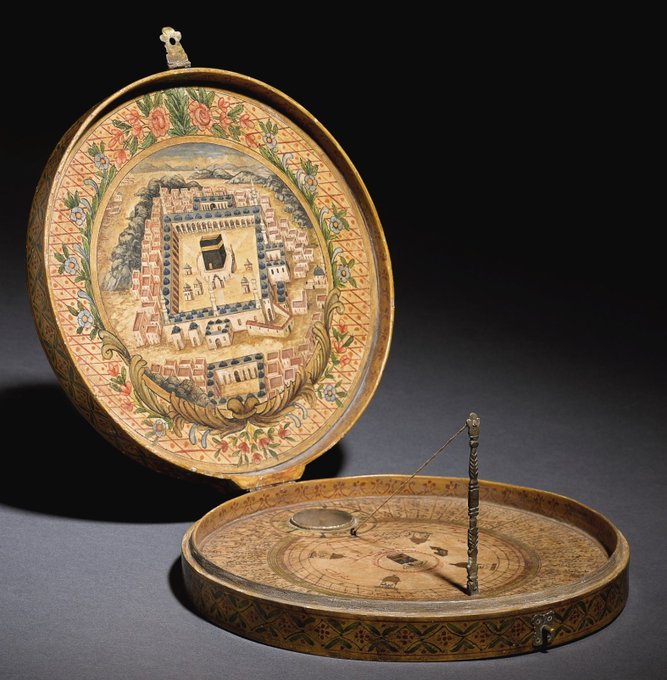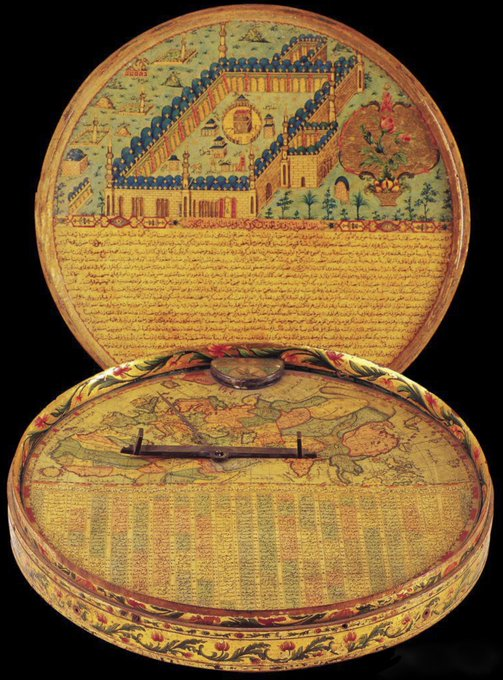2/ Qibla Finder, 19th century, Turkey The interior of the base depicting the Ka'ba, encircled by names of various cities, the interior of the lid with a larger view of Mecca.
3/ Qibla Finder, 1582-1583 (990 AH) (990 AH), Egypt Horizontal sundial, with a depiction of the Ka’ba in the centre. Constructed for the latitude of Istanbul, this is one of the more unusual examples of instruments.
4/ Qibla Finder, 1738–9, Sultanahmet, Istanbul, Turkey The qiblanuma literally means 'showing the direction to the Ka'ba'. The inside lid shows, shows the minarets of the Masjid al-Haram in Mecca, with the Ka'ba in the courtyard
4/ Qibla Finder, 1738–9, Sultanahmet, Istanbul, Turkey The qiblanuma literally means 'showing the direction to the Ka'ba'. The inside lid shows, shows the minarets of the Masjid al-Haram in Mecca, with the Ka'ba in the courtyard
5/ Qibla Finder, 19th century, Turkey
The interior of the cover with the Kaaba at the centre surrounded by the maqams of the four Sunni schools of law with a view of Mecca. The base with a compass with cruciform steel needle and glazed cover.
7/ Qibla Finder, 1700-1825, Turkey Qibla Finders are used to find the direction and time of prayer by Muslim worshippers. According to the central tenets (or five pillars) of Islam Muslims must pray five times a day.
10/ Qibla Finder, 19th century, Turkey The interior of the base depicting the Ka'ba, encircled by names of various cities, the interior of the lid with a larger view of Mecca.
12/ Qibla Finder, 19th century, Turkey The interior of the base depicting the Ka'ba, encircled by names of various cities, the interior of the lid with a larger view of Mecca
13/ Qibla Finder, 19th century, Turkey The inside of the box with a compass and compass rose in twelve directions, divided into degrees, with painted medallion view of the Al-Aqsa Mosque. This instrument, was made exclusively for Medina.
13/ Qibla Finder, 19th century, Turkey The inside of the box with a compass and compass rose in twelve directions, divided into degrees, with painted medallion view of the Al-Aqsa Mosque. This instrument, was made exclusively for Medina.
15/ Qibla Finder, 19th century, Turkey The interior of the base with the Ka'ba at the centre surrounded by the maqams of the four Sunni schools of law, around these in small naskh are the names of various cities.
16/ Qibla Finder, 19th century, Turkey The interior of the base depicting the Ka'ba, the interior of the lid with a larger view of Mecca.




















No comments:
Post a Comment